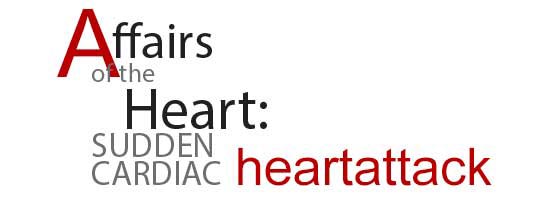It’s a common misconception that sudden cardiac arrest (SCA) and heart attack are one in the same. In reality, they are quite different. Understanding the difference could save your life—or the life of someone you love.
HEART ATTACK: A “PLUMBING PROBLEM”
Heart attack (myocardial infarction or MI) occurs when part of the heart’s blood supply is reduced or blocked, causing the heart muscle to become injured or to die. The victim is conscious and may complain of one or more of the signs and symptoms.
Signs and Symptoms of a Heart Attack
Most heart attacks involve discomfort in the centre of the chest that lasts more than a few minutes or that goes away and comes back. Some heart attack victims experience mild intermittent chest discomfort that comes and goes over a period of days. These are early “warning signs” that may precede a heart attack. Some victims, however, do not experience any warning signs.
Chest discomfort can feel like uncomfortable pressure, squeezing or fullness. It can evolve into crushing pain if nothing is done.
Other symptoms of a heart attack include:
• Pain or discomfort in one or both arms, spreading to the shoulder, upper back, neck or jaw
• Shortness of breath
• Nausea, sweating, light-headedness
• A general sense of anxiety
• A tendency to deny that anything serious is happening.
It’s important to act right away if these symptoms occur to maximise the odds of survival and reduce potential permanent damage to the heart.
Are You at Risk for a Heart Attack?
The risk factors for a heart attack include:
• A family history of heart disease
• Smoking
• High blood pressure
• High cholesterol
• Obesity
• Diabetes
• A sedentary lifestyle
• Stress
• Excessive intake of alcohol
SUDDEN CARDIAC ARREST: “AN ELECTRICAL PROBLEM”
Sudden cardiac arrest (SCA) is different from a heart attack. While a heart attack is described as a “plumbing problem,” SCA is more of an “electrical problem” that prevents the heart from functioning effectively. Heart attacks can lead to SCA, but there are many other causes, such as congenital abnormalities, severe heart failure, electrocution and drug overdose.
Signs and Symptoms
When SCA occurs, the heart stops beating altogether. As a result, blood is no longer pumped throughout the body, including the brain. The person suddenly passes out, loses consciousness, and appears lifeless—except for abnormal “gasping” which may last for several minutes. Occasionally, SCA victims will experience 10-20 seconds of seizure activity (shaking of the arms and legs) at the onset of the event as the brain stops receiving blood and oxygen from the heart.
The SCA victim is never awake and needs immediate help. If nothing is done, the victim will die within minutes.
Lifesaving Actions
When SCA occurs, it is critically important that whoever is near the victim calls for medical help immediately, checks for signs of life, and if there are none, gives CPR and uses the nearest automated external defibrillator (AED).
This is lifesaving care that any layperson can provide. It is best to be trained in CPR and the use of AEDs, but even without formal training, the rescuer can push hard and fast on the victim’s chest and follow the directions on the AED, while awaiting medical help to arrive.
To continue reading, purchase Vol.8 #10, 2017 Issue.

